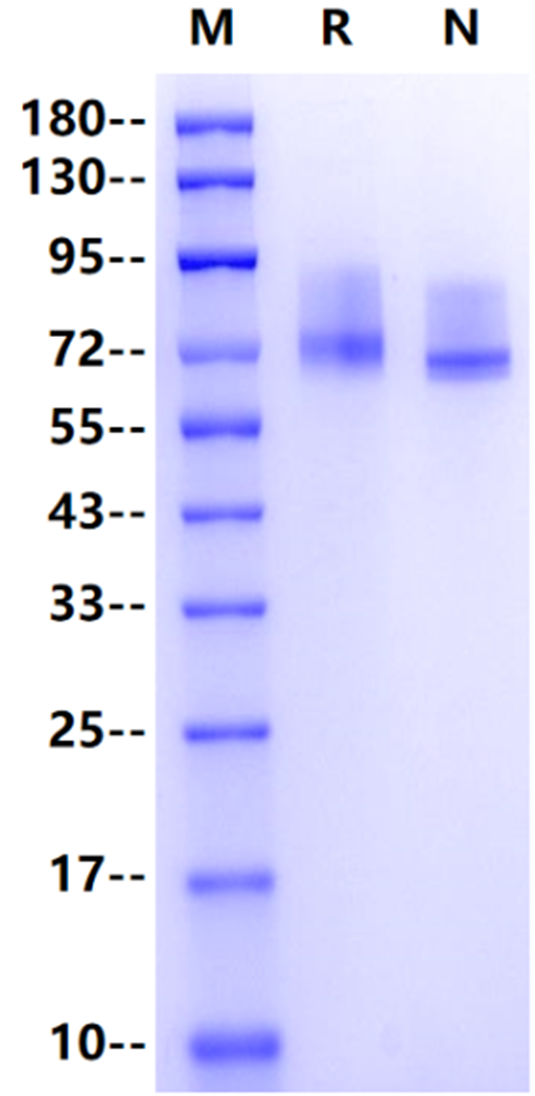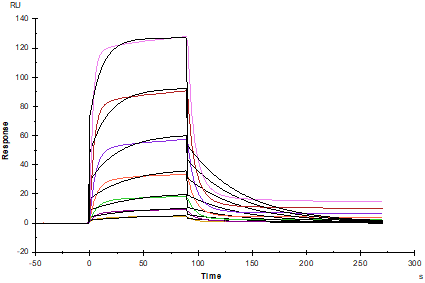Glu34-Ala565, with C-terminal 10*His EEVILLDSKASQAELGWTALPSNGWEEISGVDEHDRPIRTYQVCNVLEPNQDNWLQTGWISRGRGQRIFVELQFTLRDCSSIPGAAGTCKETFNVYYLETEADLGRGRPRLGGSRPRKIDTIAADESFTQGDLGERKMKLNTEVREIGPLSRRGFHLAFQDVGACVALVSVRVYYKQCRATVRGLATFPATAAESAFSTLVEVAGTCVAHSEGEPGSPPRMHCGADGEWLVPVGRCSCSAGFQERGDFCEACPPGFYKVSPRRPLCSPCPEHSRALENASTFCVCQDSYARSPTDPPSASCTRPPSAPRDLQYSLSRSPLVLRLRWLPPADSGGRSDVTYSLLCLRCGREGPAGACEPCGPRVAFLPRQAGLRERAATLLHLRPGARYTVRVAALNGVSGPAAAAGTTYAQVTVSTGPGAPWEEDEIRRDRVEPQSVSLSWREPIPAGAPGANDTEYEIRYYEKGQSEQTYSMVKTGAPTVTVTNLKPATRYVFQIRAASPGPSWEAQSFNPSIEVQTLGEAASGSRDQSPAGGGSGGGSHHHHHHHHHH
1. Jing Peng, Danhua Zhang. Coexpression of EphA10 and Gli3 promotes breast cancer cell proliferation, invasion and migration, J Investig Med. 2021 Aug;69(6):1215-1221. Epub 2021 May 14.
2. Kullander K., Klein R. Mechanisms and functions of Eph and ephrin signalling. Nat. Rev. Mol. Cell Biol. 2002;3:475-486.
3. Dodelet V.C., Pasquale E.B. Eph receptors and ephrin ligands: Embryogenesis to tumorigenesis. Oncogene. 2000;19:5614-5619.
4. Aasheim H.C., Patzke S., Hjorthaug H.S., Finne E.F. Characterization of a novel Eph receptor tyrosine kinase, EphA10, expressed in testis. Biochim. Biophys. Acta. 2005;1723:1-7.
5. Nagano K., Maeda Y., Kanasaki S., Watanabe T., Yamashita T., Inoue M., Higashisaka K., Yoshioka Y., Abe Y., Mukai Y., Kamada H., Tsutsumi Y., Tsunoda S. Ephrin receptor A10 is a promising drug target potentially useful for breast cancers including triple negative breast cancers. J. Control Release. 2014;189:72-79.
Ephrin receptors (Ephs), the largest subfamily of receptor tyrosine kinases, are known to modulate cell–cell signaling by interacting with cells’ membrane-bound ephrin ligands on neighboring cells, thereby regulating tissue organization, vascular development, and progression of many diseases including cancer. Ephrin receptor A10 (EphA10), a member of the Eph subfamily, is not expressed in normal human adult tissue except in the testis. The Eph/ephrin signaling mediates cell-cell interaction and contributes to the tumorigenesis, angiogenesis and metastasis in many cancers. EphA10 expression is common in malignant cells across histology of various tumors and has been associated with poor prognosis in patients with breast, prostate, and gallbladder cancers.

1μg (R: reducing conditions, N: non-reducing conditions).

Immobilized EphA10 His Tag, Human (Cat. No. UA010609) at 1.0μg/mL (100μL/well) can bind Ephrin-A3 Fc Chimera, Human (Cat. No. UA010141) with EC50 of 0.23-2.35μg/ml.

Protein A Chip captured Ephrin-A3 Fc Chimera, Human (Cat. No. UA010141), can bind EphA10 His Tag, Human (Cat. No. UA010609) with an affinity constant of 57.08nM as determined in SPR assay.